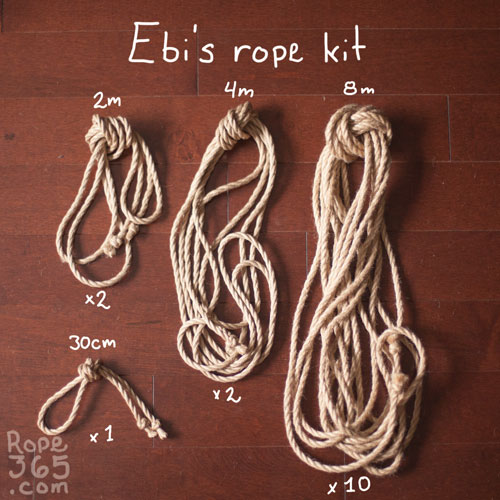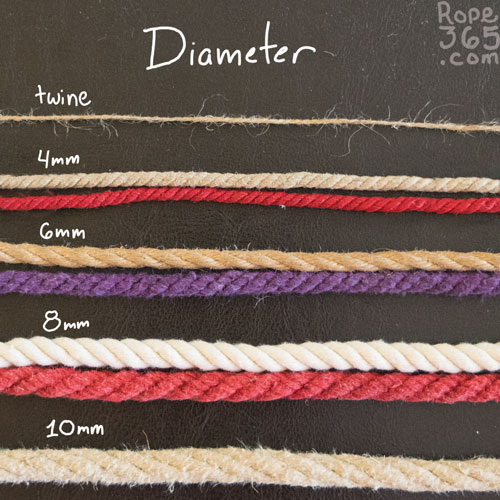Day 43: Size
It is said that there are only two lengths of rope, too short and too long! The reality is that we have to build a system that fits our preferences and create our rope kit accordingly. Depending on our style, technique and the type of ties we like to create, we may opt to have a different combo of rope lengths in our kit.
Building a System of Rope Length
The Perfect Length Every Time
Some people like to have many different lengths and pick the one closest to their needs. This way they can use an extra-long piece to make a complex corset tie without having any joints in the way or use a shorter one to make a simple tie more efficiently. With this approach, it is common to add a colour code on the rope so they are easier to tell apart. Having different lengths also means you need to have a good idea of the tie in mind and how much rope it will need, which requires more preparation.
This approach is popular with people who like western bondage aesthetics, damsel in distress style and complex decorative rope. We often see kits for sales with different lengths in them. For example: 2x4m 4x8m, and 1×10+m or a similar distribution of 15’ 30’ 50’ in imperial measurement.
One Length to Rule them All
Some people think it is best to have only one length in their bag. You learn to work with that length and master it. By extending the ropes, you can keep on tying as if your rope was infinite. This is great when you like to improvise and don’t know in advance how much rope you will need. With only one length, you can pick any rope in your bag and be sure of what you’ll get.
This approach is popular in the Japanese style and among connective bondage enthusiasts. We often see kits for sale with several of the same length, usually between 7-9 meters or 30’.
Favourite Length
No matter the style, most of the ropes in a kit will be of the “favourite length”. This preferred length is usually somewhere between having to connect rope too often (too short), and spending too much time dragging the rope (too long).
A common technique is to use the arm span of the person tying as a measurement guideline. The longer the arms, the longer the rope. Make one wrap around a partner and measure how much rope you can pull with two movements. For most people, this will be around 8m.
Some will prefer to have a kit dedicated to a specific person to be tied with. In that case, it can be interesting to cut it to a length where the joints are well positioned for your favourite ties. It is common among performers to see a kit where two or three of the ropes are cut to tie a box tie with the extensions perfectly located.
Shorties
These moments where you only need an inch of rope to finish a tie happens all the time. This is why many people carry some small ropes in their bags. Even people who believe in the “one length to rule them all” sometimes carry a few of them. They will generally be stored separately or made small enough not to be confused with the “favourite” length. Shorties are usually between 30 cm and 4m.
Rope Diameter
Diameters for rope bondage generally range between 4-8mm with most people opting for 6mm. Small diameters create knots that are leaner and are great for more detailed work. Larger diameters will have more surface and can offer more comfort but will create bulkier knots. It is both an aesthetic and a practical decision. The diameter of the rope may also change with use, as the rope is stretched and polished, it may lose a few millimetres.
Practice Time!
Trying things out is the best way to feel the difference between different rope size. Get some cheap ropes, and get ready to cut it up!
- Tie your favourite tie using a very long rope, 15m or more.
- Now cut a meter off and tie the same thing again.
- Repeat a few times, as you feel you are getting closer to a comfortable length, reduce the rope(s) by a smaller amount.
- Keep track of the length that was the best to tie with.
Exploration ideas
- Try with different ties, chest harness, box tie, frog tie, etc.
- Repeat the exercise with ropes of different diameters, what size is your favourite?
- Compare knots size between rope of different diameter
Inspirations and Resources
Credit: R/P: Ebi McKnotty
Or return to The Rope for more options.



Leave a Reply